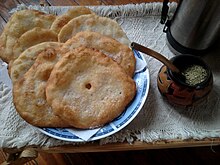Sopaipilla
 A New Mexican dessert sopaipilla | |
| Type | Doughnut |
|---|---|
| Main ingredients | Leavening agent, wheat dough (or wheat flour and masa harina), shortening or butter |
A sopaipilla, sopapilla, sopaipa, or cachanga[1] is a kind of fried pastry and a type of quick bread served in Argentina,[2] Bolivia,[2] Chile,[2][3] New Mexico,[4] Colorado,[5] Peru,[1] Texas,[6] and Uruguay.[7] The word sopaipilla is the diminutive of sopaipa, a word that entered Spanish from the Mozarabic language of Al-Andalus.[8] The original Mozarabic word Xopaipa was used to mean bread soaked in oil, and derived in turn from the Germanic word suppa which meant bread soaked in liquid.[2]
A sopaipilla is traditionally made from leavened wheat dough (or a mixture of wheat flour and masa harina) to which some shortening or butter is added. After being allowed to rise, the dough is rolled into a sheet that is then cut into circular, square or triangular shapes. The shapes are 8–10 cm in size for the longest dimension (if intended for a dessert) or 15–20 cm (if intended to be stuffed for a main course). The shapes are then deep-fried in oil, sometimes after allowing them to rise further before frying: the frying causes the shapes to puff up, ideally forming a hollow pocket in the center.[9]
Variations
Argentina

In Argentina pastry is known under other names apart from sopaipa, supaipa and sopaipilla these are; Torta frita, Kreppel and chipá cuerito.[2]
Chile

In Chile, sopaipillas (or sopaipas) are known to have been eaten at least since 1726.[8] Although Traditional Chilean sopaipillas (made in the central part of Chile) include zapallo (pumpkin) in their dough, it wasn't typically used in the South of Chile.[2] Depending if they are served as a pastry or bread Chilean sopaipillas are traditionally served with either pebre (a sauce of onion, tomato, garlic, and herbs) or chancaca sauce (and then they are called sopaipillas pasadas). They are also served with mustard, ketchup, hot butter, guacamole, cheese or manjar.[2][3][8] In Chile sopaipillas are traditionally made and eaten during days of heavy rain.[2] Chilean sopaipillas are round and made flat by holes, usually made by forks.

Peru
In Peru the name for this fried pastry is cachanga, and it may be either sweet or sour.[1][10] Generally prepared during breakfast time, this traditional food of the Peruvian cuisine is prepared differently depending on the region,[10] with one of the recipes involving the usage of cinnamon.[1] The main difference between this form of sopaipilla and the other versions is that they are larger, thinner, and more rigid.[10]
United States

Common throughout the American Southwest, it is generally served as a dessert with honey poured between its two layers. New Mexican cuisine typically serves them in place of bread, or filled with ingredients common to tacos and enchiladas.
Sopaipilla and strudel were together designated as Texas' state pastries from 2003 to 2005.[6]
A simple imitation of a sopaipilla can be made by frying a flour tortilla until it puffs up then cutting it into triangles and serving with honey.
Uruguay
In Uruguay a variant of the Sopaipilla is known as Torta frita.[7]
See also
![]() Media related to Sopaipillas at Wikimedia Commons
Media related to Sopaipillas at Wikimedia Commons
References
- ^ a b c d Peru handbook, page 506
- ^ a b c d e f g h Correa, Adriana. Comida de larga tradición Diario de Cuyo
- ^ a b Burford, Tim (March 2005). Chile: The Bradt Travel Guide. Bradt Travel Guides. p. 87.
- ^ Chávez, Thomas E. (1 October 2006). New Mexico Past and Future. University of New Mexico Press. ISBN 0-8263-3444-X.
- ^ Painter, Kristen (March 28, 2014). "Casa Bonita celebrates 40 years of sopapillas and cliff diving". The Denver Post. Retrieved March 30, 2014.
- ^ a b "Texas State Symbols". Texas State Library & Archives Commission website. 10 August 2009.
- ^ a b "Torta Frita Cuando Llueve". Montevideo.gub.uy. Retrieved 2010-11-21.
- ^ a b c San Juan, Verónica. "¿Por qué se llaman como se llaman?". Revista Mujer (in Spanish). La Tercera. Retrieved 21 February 2010.
{{cite web}}: Unknown parameter|trans_title=ignored (|trans-title=suggested) (help) - ^ Cynthia Detterick-Pineda.Recipe: New Mexico Sopapillas. URL: http://whatscookingamerica.net/CynthiaPineda/Sopapillas/Sopapillas.htm
- ^ a b c http://www.mis-recetas.org/recetas/show/7954-cachanga
Further reading
- Sheila MacNiven Cameron, ed. (1978). The Best from New Mexico Kitchens. New Mexico Magazine. ISBN 0-937206-00-8.

